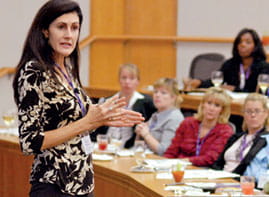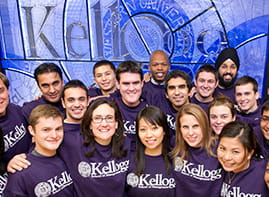IDEO Partner Tom Kelley talks creativity and how to bring it into an organization
6/9/2016 -
Speaking before a crowd of students, faculty and alumni at the Jacobs Center,
IDEO Partner Tom Kelley discussed how bringing creativity into the workplace can help employees deal with the everyday challenges of operating a business.
A world-renowned innovation expert and author of
The Ten Faces of Innovation,
The Art of Innovation, and
Creative Confidence, Kelley was the inaugural speaker of the Segal Design Speaker Series, a collection of talks at the Kellogg School of Management sponsored by Crate & Barrel Co-founders Gordon I. Segal ’60 and Carole Segal (WCAS60).
Kelley’s talk, based on the idea of “creative confidence,” focused on the notion that most people have the capacity to develop fresh, original ideas based on their own experiences and perspectives, but lack the confidence to present those concepts for a myriad of reasons.
“People must have the courage to act,” Kelley says. “We may not know if it’s a good idea, but we need that idea because we’re facing problems that are unprecedented, and we are going to need every little bit of creative juice we can muster.”
The series was created to connect students to leaders in the world of design, who use iterative and experiment-driven methods that help bring new ideas to life, said
David Schonthal ’09, a clinical associate professor of innovation and entrepreneurship at Kellogg and a Director in the business design arm of IDEO.
Through the series, students gain a first-hand look into design thinking and its innovative, problem-solving capabilities.
“Design is playing an increasingly important role in the innovation curriculum at Kellogg,” Schonthal said. “The Segal Design Speaker Series enables students to hear directly from the best and most visionary leaders in the field, the ones who are constantly evolving and redefining the role that human-centered design plays in the world of business.”
Employees must bring their full selves to work
People understand that creativity is essential to the workplace, Kelley said. Citing an Abode survey, Kelley says that 80 percent of workers believe that creativity is critical to economic growth.
The survey also discovered that most people do not live up to their creative potential. Only 25 percent of those surveyed said they bring their full creative selves to work.
Rather than dwell on that statistic, Kelley posited a challenge to students: “How might we unlock the creative confidence of the other 75 percent?” Business leaders must find a way to convince employees to bring their entire creative selves to work, he said. Doing so will give business leaders an invaluable resource and a competitive advantage.
“If you could get your team or your company to somehow get near 100 percent of its creative capacity while the rest of the world is still at 25 percent, it wouldn’t even be a fair fight,” Kelley says. “This is why it’s worthy of your time and attention.”
Three steps to building creative confidence
In order to build creative confidence in organizations, Kelley says leaders should follow these three steps:
1. Blend technology with humanity. Business leaders should use empathy in their approach to technology to gain additional insight into their customers. Kelley gave the example of GE Healthcare’s Doug Dietz, who has designed diagnostic equipment for more than 20 years. One day, Dietz met a 6-year-old girl who was about to go into his newly designed MRI scanner. She was crying because the machine frightened her.
Dietz learned that the scanner frequently frightened pediatric patients, and worked with GE to tweak the scanning experience, turning it into a pirate adventure story for kids, complete with graphics added to the scanner and scanning suite. The result: happier kids, relieved parents and positive publicity for GE.
“He didn’t change the technology,” Kelley says of Dietz, “he introduced the right amount of humanity, and it changed the industry and his career.”
2. Treat life like an experiment. Be willing to fail, at least in small ways. Of course, you have to find a way to fail cheaply and quickly, but try more stuff.
Kelley gave another example: Sir James Dyson of the eponymous-named, best-selling vacuum cleaner company. Dyson built more than 5,120 prototypes of the first bagless vacuum cleaner before finally settling on a design in 1991.
“He wasn’t failing randomly, he was failing forward,” Kelley says, “and he learned from each prototype.”
3. Leverage storytelling. While data and proof points are integral in convincing others in business, they can also be fragile and forgettable. Stories, on the other hand, have a certain stickiness to them, so telling stories to illustrate ideas makes them more memorable for others.
Demonstrating his point, Kelley told the story of Hachikō, an eight-year-old Japanese akita dog that would walk to a train station in Tokyo every day with his owner, a local architecture professor. Hachikō would wait at the station until the professor returned from work so they could walk home together.
One day in 1925, the professor suffered a cerebral hemorrhage and died while at work. Hachikō stayed at the station for the next eight years awaiting his owner’s return, until he died in 1932. The story of Hachikō continues to be passed down through generations, having been the subject of several films and publications. To this day a statue of Hachikō sits in front of the train station.
“If you’ve got data, if you’ve got a message, wrap it in a story,” Kelley says. “Let the story carry the information for you.”
Jessica Tsai ’17, who served on the executive planning team of the student-run Kellogg Innovation and Design Association (IDEA), praised Kelley for his passion and ability to draw a connection between design thinking and the rest of the business world.
“Design thinking applies across all industries,” Tsai says. “Regardless of whether you’re working in strategy innovation or even finance, to think like a design thinker and have that kind of empathy or understanding to solve problems is really huge.”






